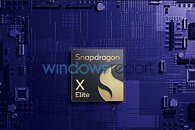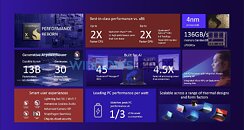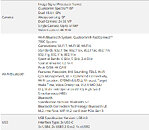- Joined
- Aug 19, 2017
- Messages
- 2,805 (1.02/day)
Thanks to the information from Windows Report, we have received numerous details regarding Qualcomm's upcoming Snapdragon Elite X chip for laptops. The Snapdragon Elite X SoC is built on top of Nuvia-derived Oryon cores, which Qualcomm put 12 off in the SoC. While we don't know their base frequencies, the all-core boost reaches 3.8 GHz. The SoC can reach up to 4.3 GHz on single and dual-core boosting. However, the slide notes that this is all pure "big" core configuration of the SoC, so no big.LITTLE design is done. The GPU part of Snapdragon Elite X is still based on Qualcomm's Adreno IP; however, the performance figures are up significantly to reach 4.6 TeraFLOPS of supposedly FP32 single-precision power. Accompanying the CPU and GPU, there are dedicated AI and image processing accelerators, like Hexagon Neural Processing Unit (NPU), which can process 45 trillion operations per second (TOPS). For the camera, the Spectra Image Sensor Processor (ISP) is there to support up to 4K HDR video capture on a dual 36 MP or a single 64 MP camera setup.
The SoC supports LPDDR5X memory running at 8533 MT/s and a maximum capacity of 64 GB. Apparently, the memory controller is an 8-channel one with a 16-bit width and a maximum bandwidth of 136 GB/s. Snapdragon Elite X has PCIe 4.0 and supports UFS 4.0 for outside connection. All of this is packed on a die manufactured by TSMC on a 4 nm node. In addition to marketing excellent performance compared to x86 solutions, Qualcomm also advertises the SoC as power efficient. The slide notes that it uses 1/3 of the power at the same peak PC performance of x86 offerings. It is also interesting to note that the package will support WiFi7 and Bluetooth 5.4. Officially coming in 2024, the Snapdragon Elite X will have to compete with Intel's Meteor Lake and/or Arrow Lake, in addition to AMD Strix Point.


Additionally, we have previously reported that Qualcomm is insisting on integrating its own PMICs (Power Management Integrated Circuits), which are inherently designed for cell phones, causing significant compatibility and efficiency issues in the deployment of this new Snapdragon Elite X processor. Also, the company advertises the SoC as capable of running 13 billion-parameter models, as well as 7B models at 70 tokens per second. This means that local LLM inference will be very efficient. To learn more, we still have to wait for any official reviews coming next year. Below, you can see the complete specification table, courtesy of Windows Report.


View at TechPowerUp Main Site | Source
The SoC supports LPDDR5X memory running at 8533 MT/s and a maximum capacity of 64 GB. Apparently, the memory controller is an 8-channel one with a 16-bit width and a maximum bandwidth of 136 GB/s. Snapdragon Elite X has PCIe 4.0 and supports UFS 4.0 for outside connection. All of this is packed on a die manufactured by TSMC on a 4 nm node. In addition to marketing excellent performance compared to x86 solutions, Qualcomm also advertises the SoC as power efficient. The slide notes that it uses 1/3 of the power at the same peak PC performance of x86 offerings. It is also interesting to note that the package will support WiFi7 and Bluetooth 5.4. Officially coming in 2024, the Snapdragon Elite X will have to compete with Intel's Meteor Lake and/or Arrow Lake, in addition to AMD Strix Point.


Additionally, we have previously reported that Qualcomm is insisting on integrating its own PMICs (Power Management Integrated Circuits), which are inherently designed for cell phones, causing significant compatibility and efficiency issues in the deployment of this new Snapdragon Elite X processor. Also, the company advertises the SoC as capable of running 13 billion-parameter models, as well as 7B models at 70 tokens per second. This means that local LLM inference will be very efficient. To learn more, we still have to wait for any official reviews coming next year. Below, you can see the complete specification table, courtesy of Windows Report.


View at TechPowerUp Main Site | Source




